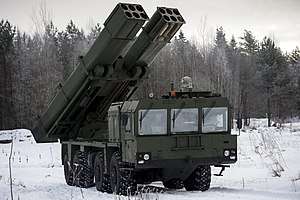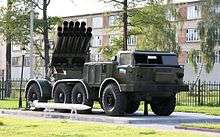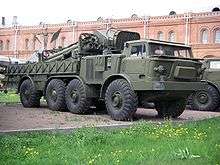BM-27 Uragan
The BM-27 Uragan (Russian: Ураган, lit. 'Hurricane'; GRAU index 9P140) is a self-propelled multiple rocket launcher system designed in the Soviet Union. It began its service with the Soviet Army in the late 1970s, and was its first modern spin and fin stabilized heavy multiple rocket launcher.
| BM-27 Uragan (9P140) | |
|---|---|
  BM-27 Uragan BM-27M Uragan-1M | |
| Type | Multiple rocket launcher |
| Place of origin | Soviet Union |
| Service history | |
| In service | 1975 – present |
| Used by | See Operators |
| Wars | Soviet–Afghan War[1] First Chechen War[1] Second Chechen War[1] Russo-Georgian War[1] War in Donbass[1][2] Iran-Israel proxy conflict[3] Syrian Civil War[1] |
| Production history | |
| Designer | Splav State Research and Production Enterprise |
| Designed | 1970s |
| Manufacturer | Splav State Research and Production Enterprise |
| Produced | 1975 – present |
| Variants | See Variants |
| Specifications | |
| Mass | 20 tonnes (44,092 lbs) |
| Crew | 6 |
| Calibre | 220 mm (8.66 in) |
| Barrels | 16 |
| Effective firing range | 35 km (22 mi) |
| Sights | PG-1 panoramic telescope |
| Engine | Two engines, with separate gearboxes and propeller shafts, that are longitudinally mounted, one on each side of vehicle immediately behind cab |
| Suspension | 8×8 wheeled |
Operational range | 500 km (311 mi) |
Description
The BM-27 Uragan is capable of launching 220 mm rockets from 16 launch tubes mounted on the rear of a ZIL-135 8x8 chassis.[4] This vehicle is extremely similar to that used in the FROG-7 free flight rocket system. It has two gasoline engines that power its 20 tonnes to a maximum speed of 65 kilometers per hour. One engine drives the four wheels on the left of the truck, while the other engine drives the four wheels on the right. The ZIL-135 has eight wheel drive, but only the front and rear axles are used for steering. It has a maximum cruising range of 500 kilometers.
The cab of the ZIL-135 is NBC protected, allowing the rockets to be fired without exposing the crew to possible contaminants.[5][6] The six-man crew[4] can emplace or displace the system in three minutes.
Before firing, stabilizing jacks must be lowered and the blast shield raised to protect the cab and its occupants. Indirect fire aiming is achieved with the use of a PG-1 panoramic telescope. Although there are no night vision sights, the driver of the launch vehicle is equipped with a night vision device.
The BM-27 can use HE-FRAG, chemical, explosive or scatterable mine (PTM-3 or PFM-1) submunition equipped rockets, all of which are detonated by electric timing fuses. Each rocket weighs 280.4 kilograms. The warheads weigh between 90 and 100 kilograms, depending on type. A full salvo of 16 rockets can be fired in 20 seconds and can engage targets within a range of 35 kilometers.
Because of the size of the warhead, the range of the rocket and the speed that a salvo can be delivered, the BM-27 is very effective at mine laying. Each 220 mm rocket can scatter 312 anti-personnel PFM-1 mines. Minefields can be laid behind a retreating enemy or even be used to trap an enemy by encircling them with mines. Tactics such as this were often used by the Soviets in Afghanistan.
Once the rockets have been fired, 9T452 (another ZIL-135 based vehicle) is used to assist in reloading. It carries additional rockets and a crane to transfer the rockets from the reload vehicle to the launcher.[4] The entire reloading procedure takes around 20 minutes.
 The 9P140 missile launcher vehicle as a monument to A.N. Ganichev near Splav State Research and Production Enterprise, Tula city |
 The 9T452 transporter-loader vehicle at the St Petersburg Artillery Museum |
Variants
- 9P140 Uragan: Standard variant on ZIL-135 truck.
- Uragan-1M: Variant presented to the public in 2007; all processes are automated. Can also fire the 300 mm rockets of the BM-30 Smerch system.[7] Reloading is simplified by substituting barrels; can be fitted with two banks of 6 300 mm launch tubes or 15 220 mm launch tubes. Deliveries to the Russian Army started as of September 2016.[8][9][10]
- 9A53 Uragan-U: Successor with 2 × 15 launch tubes; presented in 2009 on 8×8 MZKT-7930. Thanks to its modular assembly the BM-30 Smerch and BM-21 Grad rockets can also be fired.
- Bastion-03: Prototype by Ukrainian company AvtoKrAZ, presented in 2010. Installed on a 6×6 truck type KrAZ-63221RA.[11]
Operators




















See also
- Katyusha BM-31 multiple rocket launchers of World War II
- BM-24 240 mm multiple rocket launcher
- BM-30 Smerch 300 mm heavy multiple rocket launcher
- 9A52-4 Tornado 122 mm / 220 mm / 300 mm universal multiple launch rocket system
- MAR-290 heavy multiple rocket launcher
- MLRS M270 227 mm multiple rocket launcher
- HIMARS, lighter version of the above
- Fajr-5 333 mm rocket launcher
- TOROS 230-260 mm rocket launcher
- Falaq-2 Unguided rocket launcher
References
- Prenatt 2016, p. 37.
- Salem, Harriet. "'I Couldn't Move for Five Minutes from Fear': An Investigation Into Cluster Bombs in Eastern Ukraine". Vice.com. Vice. Retrieved 23 October 2014.
- https://www.telegraph.co.uk/news/2018/05/10/israel-fires-barrage-missiles-syria-accusing-iranian-forces/
- Prenatt 2016, p. 36.
- Red Steel: Soviet Tanks and Combat Vehicles of the Cold War, by Russell Phillips, pub Shilka, 2013, p140.
- WeaponSystems.net, BM-27 Uragan.
- Бикалиберная РСЗО «Ураган-1М» прошла государственные испытания Archived 25 August 2015 at Archive.today, warfiles.ru, Retrieved: 25 August 2015 (Russian)
- "ЦАМТО / Новости / Серийные поставки реактивных систем залпового огня «Торнадо-С» планируется начать в 2017 году". www.armstrade.org. Retrieved 13 April 2018.
- Russian armed forces will receive new Uragan-1M multi-caliber multiple launch rocket system - Armyrecognition.com, 22 September 2016
- "Новейший реактивный «Ураган-М1» (видео) - Еженедельник «Военно-промышленный курьер»". vpk-news.ru. Retrieved 13 April 2018.
- KrAZ Military Vehicles, issuu.com, Retrieved: 19 February 2016
- Military Balance 2016, p. 182.
- Military Balance 2016, p. 444.
- Military Balance 2016, p. 449.
- Military Balance 2016, p. 185.
- Military Balance 2016, p. 187.
- Military Balance 2016, p. 188.
- Military Balance 2016, p. 190.
- Military Balance 2016, p. 354.
- Military Balance 2016, p. 203.
- Military Balance 2016, p. 205.
- Military Balance 2016, p. 208.
Bibliography
- Prenatt, Jamie; Hook, Adam (2016). Katyusha – Russian Multiple Rocket Launchers 1941–Present. New Vanguard 235. Oxford: Osprey Publishing Ltd. ISBN 978-1-4728-1086-1.
- International Institute for Strategic Studies (February 2016). The Military Balance 2016. 116. Routlegde. ISBN 9781857438352.
External links
| Wikimedia Commons has media related to BM-27 Uragan. |